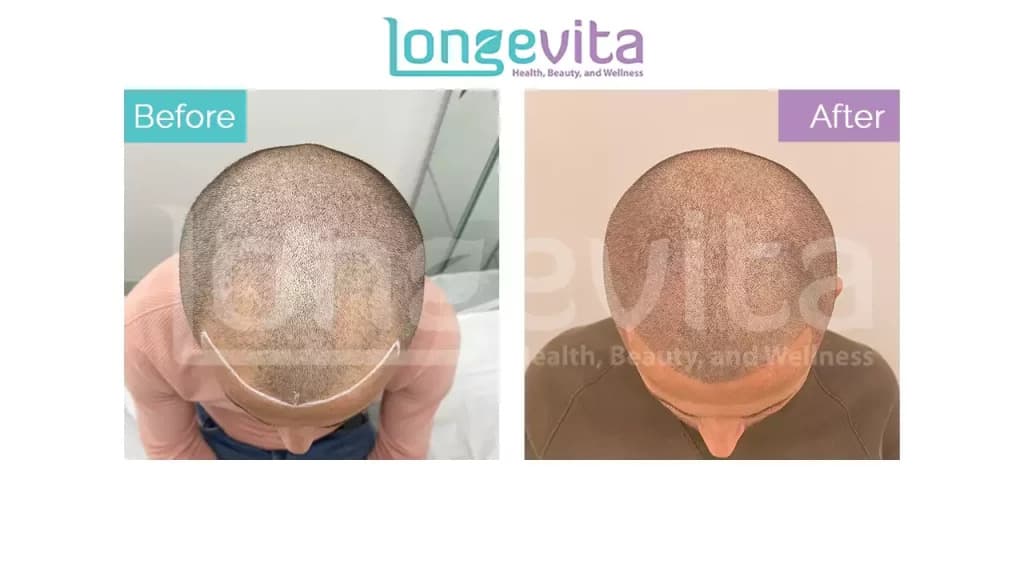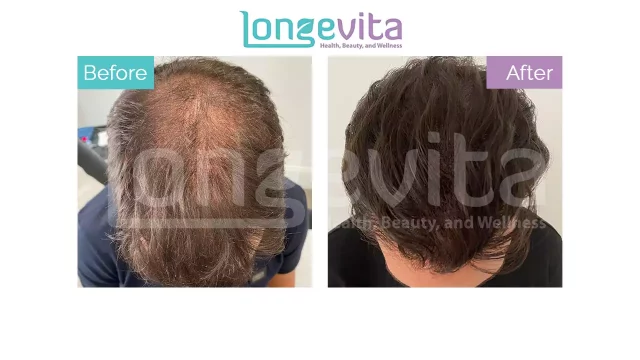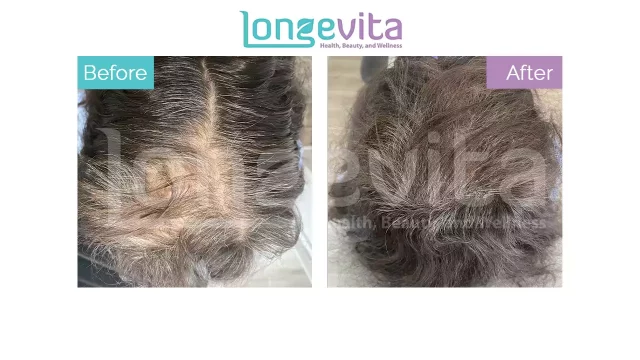Scalp micropigmentation (SMP) is a non-surgical hair loss solution for people who are ineligible for hair transplants or cannot achieve high hair density because of weak donor areas.
SMP uses an advanced medical-grade tattoo machine to achieve the best possible results.
What Is Scalp Micropigmentation?
Scalp micropigmentation involves the insertion of microdots of pigment in the upper dermis of the scalp.
The size of the dots and the spacing between them are meant to replicate the existing hair follicles.
The practitioner will layer the pigment on the scalp. If you had SMP on a bare scalp, it would look like a buzz-cut.
To avoid any future scalp micropigmentation regrets, make sure to find a practitioner who has the necessary training, licensing and certifications.
Experienced practitioners are aware of the anatomical differences in scalps, skin tone, and skin type of people. They also consider a patient’s medical history and scalp health.
Good practitioners also adjust the angling, depth, and duration of the needle penetration across different areas of the scalp to achieve the desired effect.
Poor technique can result in a tattoo blowout. The wrong choice of pigment or size/shape of the needle can also ruin the results of the procedure.
How Much Does Scalp Micropigmentation Cost?
A single hair micropigmentation session might cost you as much as £500. And if you’re looking for full coverage, it might cost you anywhere from £2,000 to £3,000.
The area of treatment and the number of sessions needed will all determine how much is scalp micropigmentation.
Also, scalp micropigmentation’s cost varies according to the needs of the patients, whether the patient’s getting SMP for balding, thinning, camouflaging scars, or augmenting hair transplant.
Who Can Benefit from Scalp Micropigmentation?
You are a suitable candidate for scalp micropigmentation if you have a:
Weak Donor Area
If you’re not eligible for a hair transplant in Istanbul due to a weak donor area, SMP can fill up the bald spots on your scalp.
Keep in mind that grafting from weak donor areas can permanently damage them. So, it’s better to look for alternatives like micropigmentation of the scalp.
Low Hair Density
Progression of hair loss due to androgenetic alopecia, hormonal imbalance, medication or any other illness can result in low hair density.
And if you can’t undergo a hair transplant, you can give the illusion of a full head of hair with micropigmentation of hair follicles.
For instance, scalp micropigmentation for women can be helpful if they’re experiencing diffuse thinning due to pattern baldness. In this case, it’s not possible to get a hair transplant, but SMP can give good results.
A hair tattoo can also help those losing hair because of autoimmune diseases or other illnesses (or treatments).
Scarring
Some people get SMP to hide the scars on their scalps.
If you have scar tissue from physical trauma, surgery, scarring alopecia, or a strip-harvesting (FUT) hair transplant, you can consider getting this treatment.
Moreover, SMP can hide the patchy spots in the donor area from overharvesting. It can also conceal donor scars from different harvesting techniques.
Keep in mind, however, micropigmentation of the scalp does not cover keloid scars.
Contraindications for Scalp Micropigmentation
If the patient’s suffering from a heart condition, blood clotting disorder, blood-borne infectious disease, diabetes, or lupus, they cannot get SMP.
The procedure is also contraindicated for those who’re taking heart medications, blood thinners or immunosuppressants.
Those with severe epilepsy, who had a seizure in the last year, are also not eligible. It’s also not safe to get SMP during an active flare-up of psoriasis or eczema.
Inform your practitioner about all your known allergies. Also, if you’re pregnant, you’ll be advised against SMP.
Am I Suitable For Hair Transplant?
What To Think Before You Have SMP?
Micropigmentation requires specialised knowledge and skills that your operator needs to have.
To address different concerns in different areas of the scalp, the SMP practitioner adjusts the technique to achieve the best scalp micropigmentation results.

Ask the practitioner about their qualifications and experience. Moreover, you should inquire about the number of procedures they’ve performed.
It’s always a good idea to check the before and after photos. For instance, if you’re getting scalp micropigmentation for the hairline, check out the photos of patients who had the treatment in the same area.
Additionally, you should ask about the overall complication rate and potential complications of SMP. Follow-up with a question on how the practitioner dealt with them in the past.
Also, it’s important to ask them if they would recommend any alternative treatment to better help you achieve your goals.
Other than that, make sure to learn about their patient satisfaction rates and how they handle follow-up if anything goes wrong.
How Best to Prepare for Scalp Micropigmentation?
To prepare for the day of the treatment, you need to keep the following things in mind:
- Don’t shampoo your hair for at least 3 days before the first session. It can cause dryness and poor absorption of the pigment. You can use a conditioner meanwhile.
- Do not drink alcohol for at least 2 days before the treatment as it can cause increased bleeding. Moreover, it lowers the pain threshold, which can cause discomfort during the procedure.
- Do not shave your hair before the first session because the practitioner has to create a pigment match according to your existing hair. They will shave your hair in the first session.
- Do not spray on any hair fibres, as they conceal the actual shade of your existing hair and your bald patches. They can also cause infection. So, make sure it’s washed off before the treatment.
- Inform the practitioner about any medication that you’re taking.

What Is The Procedure For Scalp Micropigmentation?

The practitioner uses a handheld electric tattoo machine. It comes with needles of different sizes.
Depending on the patient’s needs, they insert the needle into the device and fill it with pigment.
The choice of pigment depends on the skin and natural pigments in the patient’s hair. It ensures natural-looking results.
After that, dots of the size of the hair follicles are made on the scalp. Typically, the entire process is completed in three sessions, which are 7-30 days apart.
- 1st Session: The practitioner will do a scalp assessment and identify the problem areas. Then, they will insert the pigment into the scalp. The microdots are spread out to avoid a blowout. The whole session may take 3-4 hours. However, it can vary depending on the area of treatment.
- 2nd Session: Usually, it takes place a week after the first session. The practitioner adds more microdots in the spaces between the ones placed in the last session. This increases the density while allowing the previous microdots to heal. It may take up to 3 hours.
- 3rd Session: Usually, it takes a month after the second session. The practitioner will make the final touches by perfecting the shade. If you’re getting a new hairline, it’ll be finalised in this session. The whole process may take up to 2 hours.
One study published in the Journal of Clinical and Aesthetic Dermatology showed very high patient satisfaction from scalp micropigmentation.
Book A Free Consultation With Our Patient Consultants
We offer free consultations for patients across the UK & Ireland, so you can discuss your individual requirements with our specialists. Book A Free Consultation With Our Patient Consultants Today.
Recovery Of Scalp Micropigmentation
You will achieve immediate results after every session. However, you won’t see the final results until after the last session.
Also, SMP has no downtime; you can go to work the next day.
Although you may experience swelling and redness for 2-3 hours after the procedure, it can vary between patients.
If you have more sensitive skin, the redness can last for 1-2 days. Many people also commonly experience itching during the recovery process.
Resist the urge to scratch or pick scabs. You can try relieving the itch by gently pressing your finger in the concerned area.
When doing so, make sure to wash your hands before to avoid an infection.
How Long Does Scalp Micropigmentation Last?
The pigments used in SMP are classified as permanent. However, each patient’s body reacts differently to the pigment.
In some cases, it starts fading as time passes. To achieve the best results, make sure that you follow the aftercare instructions.
Aftercare Of Scalp Micropigmentation
It’s important that you closely follow the aftercare instructions provided by your practitioner.
Your skin is wounded and vulnerable, so you need to take care of it. It will affect the final results of the procedure.
Washing
You should not wash or shave your head for 4 days after the procedure. Avoid any physical activity that can cause excessive scalp sweating.
On the 5th day, you can wash your scalp with clean water. The water shouldn’t be hot.
Gently massage to wash the excess pigment. After that, pat your hair dry.
At this point, you can remove scalp hair using a shaver or clipper only. You can start washing your scalp with gentle shampoo after the 10th day.
Moisturising
5 days after the procedure, start moisturising your scalp 3 times a day. If you don’t do that, it will leave the skin hard and dry for the next session.
This will make it difficult for the needle to penetrate. It can also lead to the postponement of the appointment.
After your last session, you can start moisturising daily 4 days after the treatment.
To avoid rubbing the scalp, you should also steer clear of tight headwear for 4 days post-treatment.
Physical Activities
You can engage in light exercises a week after the procedure. Avoid heavy exercising for 10 days after the treatment, as it can irritate the scalp.
You should not enter any swimming pools, hot baths, saunas, or steam rooms for a month after the last session.
Sun Exposure
Avoid direct sun exposure between sessions. You cannot apply sunscreen until 10 days after the last session when your scalp has healed.
It should be SPF 30+ if you’re out for a long time. Prolonged exposure to UV rays can speed up the fading of the pigment.
Side Effects to Expect After Scalp Micropigmentation
SMP is suitable for a wide range of ages, skin/hair colour, and skin types among men and women.
However, since every patient is unique, they may react differently to the treatment.
Side effects include:
- Redness
- Itching
- Swelling
- Dry skin
You might experience them right away, however, most patients won’t.
What Could Go Wrong After Your Scalp Micropigmentation?
If you do not carefully follow the aftercare instructions, it can cause an infection.
If you notice the following signs, immediately get in touch with your practitioner.
- Increased redness and swelling
- Burning sensation
- Tenderness/throbbing
- Pain
- Foul-smelling, yellow/green discharge
To reduce the risk of infection, make sure to wash your hands with soap and warm water before touching the scalp.
What To Do If You Have Any Problems After SMP?
Your treatment plan includes free online aftercare services.
If any complications arise after the procedure or you feel something’s wrong, immediately call or email our aftercare support staff.
Other Procedures to Have With Scalp Micropigmentation
Some people cannot achieve their desired hair density with transplantation alone due to the size of the balding area and/or poor donor area.
They can then combine scalp pigmentation in the UK with hair restoration surgery to give an illusion of higher hair density.
It’s best to get it after the 12-month recovery period of a hair transplant.
FAQ
Is scalp micropigmentation painful?
It depends on the pain threshold of the patient. However, the skin of the scalp is quite thick, which is why the treatment is not painful. It has a 2-3 rating on the pain scale.
Are the results natural-looking?
You must have realistic expectations from the treatment. Micropigmentation does not affect hair growth, nor is it a hair restoration procedure.
However, in the hands of an expert, the microdots will mimic natural hair follicles. Moreover, the prepared pigment will be according to the skin and hair colour of the patient.
Can you get scalp micropigmentation for long hair?
It is recommended that the patient get their head shaved in the first session so that the practitioner can precisely match the size of microdots with hair follicles. However, they can also get SMP on an unshaven head with long hair.
Can I get scalp micropigmentation on grey/ginger hair?
Your practitioner will mix the pigment with different solutions to best match its colour to your existing hair.
Can you put me in touch with a previous SMP patient?
Yes, you can request a meeting with a previously treated patient.
What language will the SMP practitioner and other health workers involved in my care use, and what language will my medical notes be in?
They’ll communicate with you in English, and the written notes will also be in English.
Who is my SMP practitioner, what are their qualifications and experience, and where can I verify this?
Longevita’s team will share the CV and lookbook of the practitioner with you.
Does the SMP practitioner have insurance that covers my procedure?
Yes, your practitioner has malpractice insurance.
Is scalp micropigmentation for females possible?
Both men and women can get micropigmentation on different parts of their scalp as long as there is no contraindication.
Reviewed and Approved by Trichologist Yaprak Yazan.



